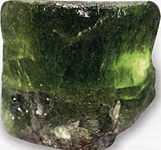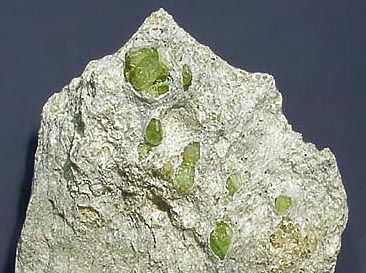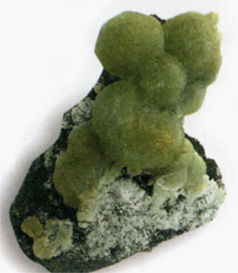Catalogue and magic properties of the stone -->rus
CHRYSOLITE (goldish-green Garnet olivine)

 Description characteristic of the mineral.
Description characteristic of the mineral.
Green and goldish-green Garnet (basalt ragstone, effusive rocks, secondary, covering stone), standing a few by oneself and today very popular. Sputnik of diamond is in deposits. Large crystals are rare and valuable, shallow chrysolites are accessible in decorations. Goldish variety of olivine (green Garnet), transparent, goldish-green. Hardness Mohs 6,5-7. Silicate of magnesium and ferrous iron, included in the group of valuable jeweller stone and minerals. The ever-higher has coefficient refractions of light and brightly flash, it is desirable to cut his large stone. Other name of the rare and valuable Ural variety of chrysolite - Demantoide (it the varieties of stone, green as a young grass, are very bright and so much sparkle). Ordinary chrysolites are palish, light and shallow enough. Chrysolite is known from the earliest times and a lot of ages is used as decorations.
Hardness of chrysolite changes in different directions. It interferes with jeweller treatment, because not all of verges of crystal identically well perceive a polish. The most valuable are consider transparent and relatively soft stone, therefore it is not recommended to carry a chrysolite in rings, because he can be scratched slightly. In this connection jewellers apply a chrysolite in other wares - brooches, ear-rings, coulombs. A large chrysolite is kept in the carbon Diamond fund. A goldish-green color has a crystal, a form is his extended, size 52х35х10,5 mm, mass 192,75 carat.
The color of Garnet chrysolite can be also presented, looking at rather yellow greenery of the ripening panary field. Green with different tints: goldish, yellow, pistachio, grass, olive, brown. Colouring very rarely intensive, more frequent than all there are chrysolites of pale tones. Sometimes stone name an evening emerald, because at lamplight a rather yellow tint disappears, and stone seems cleanly-green. In jeweller decorations a produce specialist must the diagnostician of the cut stone, if you are not sure that it is a chrysolite exactly. In shallow decorations, entangling the not valuable standards of chrysolite with anything is difficult, beginners can entangle him with fluorite or quartz, therefore we simply recommend all to memorize the characteristic color of Garnet chrysolite on a photo down.
Color of chrysolite of green with different tints - brown, goldish, yellow, tobacco, grass and other Colouring of chrysolite is conditioned a presence and different correlation of ions of ferrous iron of Fe2+ and Fe3+. Distributing of colouring in a crystal can be even and uneven, thus at the chrysolites of native deposits (obtained under earth) colouring is more intensive, than at Garnet chrysolites from superficial mineral deposits. Rarely be found as the well cut crystals, more frequent he is observed as wrong grains measuring 2-15 mm. Enough large stone are however known.
Term a chrysolite, formed from the ancient greek words of chrysos (gold) and lithos (stone), be found in century-old texts since III century B.C. there are disagreements In interpretation of modern value of this mineralogical term. In obedience to one point of view the name a chrysolite is the synonym of olivine (green Garnet). In English and German mineralogical literature jeweller olivine (silicate of magnesium and ferrous iron) is named usually peridote. In obedience to other point of view olive, chlorine or goldish chrysolites are the transparent variety of olivine, peridote is considered only the variety of chrysolite. A situation is complicated yet and that Garnet Demantoides (plutonite intrusion rockforming stone) named the Ural chrysolites are rare varieties of transparent bright green Garnet-andraite. In any case, word a chrysolite is more ancient, than peridote both olivine and this term firmly took the place in terminology of jewellers.
The deposits of chrysolite are related to the magmatic rocks (kimberlite, basalts). Many chrysolites are shallow, slipshod not added cutting. Chrysolite process the step cutting, diamond or as cabochon. A chrysolite is used mainly in gold wares as the cut insertions and cabochons. The chrysolites of с о act to the world market. Zaberged, from the USA and Burma. Attitude toward a chrysolite as to the jeweller stone not always was identical.
Magic properties of stone.
Mongols considered chrysolites the stone of dragon, because found them quite often in the volcanos of Khangayskogo of upland. Chrysolites as insertions in jeweller decorations were very popular in Europe in XIX century. It is today considered that a chrysolite is able to caution the proprietor from unreasonable acts and will help to find the lost confidence in life after the attack of disappointment. They are carried rather as amulets and talismans and rarer as simply jeweller decorations.
Instrumental in friendship and delivers from envy. Barriers from unreasonable acts and bad sleeps, strengthens forces and allots for free to predict the future. It the wonderful guarded from bad sleeps, fires, undriving, when, it would seem, be found on a way all, what only can be thought of, to fail business or even right through life. Chrysolite is a talisman of unlucky. But he and talisman of aspiring to knowledges, and than more they mysterious enigmatic secretive, the a chrysolite helps anymore: it opens secrets, does them mi is accessible and even can teach ability to create that primitive reason will name "focus". Chrysolite is amulet, charm, talisman bankers, financiers, advocates, judges and other people, trying to manage justice (even even and domestic): stone aims to send a people to the feasance of correct and moral acts and also works above his intellect. Talisman of enterprising, bold, scalene developed people, aspiring to pass to other a lot of knowledges, inventors, innovators. It also the strong guarded against stupor situations and essences, against blocks to advancement. It so loves and habit to the owner, that, given a present to other, can lost or will crack. It gives a proprietor unusually penetrating, grabbing a mind, aspiration to renew itself, surroundings and world in general, presents an owner new ideas and revelations, provides with his force of wonderful speaker.
Chrysolite is considered a strong amulet which drives away demons. As a talisman, grants the proprietor quiet sleep, likings of circumferential, successes in businesses. Wakes up passion in men. It is carried on a left arm, gold-bound. Chrysolite be found in meteorites, one of the Martian mountains is adopted them. Plays in the favour of Lions, and Pisces must beware him. Strengthens spiritual forces of the possessor and allots for free predictions.



Poisonous and radioactive risky hazardous cargo stone and minerals
** - are poisonous stone and minerals (mandatory verification is in the chemical analysis laboratory + on toxicity)
** - are radioactive stone and minerals (mandatory verification on a regular dosimeter + prohibition on the opened sales in the case of radio-activity over 24 milliroentgens / hour + additional measures of protection of people)
All of rare stone are subject obligatory verification on a regular dosimeter on the possible level of radiation and in a chemical laboratory on absence default of poisonous and evaporating components, dangerous for a human people and environment nature
- Free download article Very dangerous and potentially dangerous stone and minerals are in Medical stone therapeutics, with pictures, 2010 year, format of PDF, 2.80 Mb (Presentation from scientific of author K.305 of pictures of very dangerous and potentially dangerous natural stone and minerals which on a bad motive or criminal indifference can be illegally used in criminal and "underground" "Medical stone therapeutics"). Rus langv.
A catalogue of stone is all of stone in alphabetical order
- Signs of travelling traffic lane markings - to transportation and marking of dangerous load Policy Rules
- Rules of Road Transportation of Especially Dangerous Loads, Hazardous cargo commodity, signs index plate
